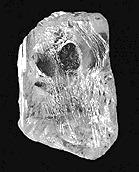
The Cullinan Diamond is the largest gem-quality rough diamond ever found, weighing 3,106 carats (621.20 g), discovered at the Premier No.2 mine in Cullinan, South Africa, on 26 January 1905. It was named after Thomas Cullinan, the owner of the mine. In April 1905, it was put on sale in London, but despite considerable interest, it was still unsold after two years. In 1907, the Transvaal Colony government bought the Cullinan and Prime Minister Louis Botha presented it to Edward VII, the British king who reigned over the territory. It was then cut by Joseph Asscher & Co. in Amsterdam.

A chemically pure and structurally perfect diamond is perfectly transparent with no hue, or color. However, in reality almost no gem-sized natural diamonds are absolutely perfect. The color of a diamond may be affected by chemical impurities and/or structural defects in the crystal lattice. Depending on the hue and intensity of a diamond's coloration, a diamond's color can either detract from or enhance its value. For example, most white diamonds are discounted in price when more yellow hue is detectable, while intense pink diamonds or blue diamonds can be dramatically more valuable. Of all colored diamonds, red diamonds are the rarest. The Aurora Pyramid of Hope displays a spectacular array of naturally colored diamonds, including red diamonds.
The Pink Star, formerly known as the Steinmetz Pink, is a diamond weighing 59.60 carats, rated in color as Fancy Vivid Pink by the Gemological Institute of America. The Pink Star was mined by De Beers in 1999 in South Africa, and weighed 132.5 carats in the rough. The Pink Star is the largest known diamond having been rated Vivid Pink. As a result of this exceptional rarity, the Beny Steinmetz Group called Steinmetz Diamonds took a cautious 20 months to cut the Pink. It was unveiled in Monaco on 29 May 2003 in a public ceremony.

Harry Winston was an American jeweler. He donated the Hope Diamond to the Smithsonian Institution in 1958 after owning it for a decade. He also traded the Portuguese Diamond to the Smithsonian in 1963 in exchange for 3,800 carats of small diamonds.
The Pink Panthers are an international jewel thief network responsible for a number of robberies and thefts described as some of the most audacious in the history of organized crime. The organization has roughly 800 core members, many of whom are ex-soldiers with extensive military and paramilitary backgrounds. Both women and men play an equal part in the structure of the organization. The organization's membership mostly consists of Serbian and Montenegrin citizens, who are believed to be Bosnian War veterans making use of their military experience for criminal activity. The organization was named by Interpol after The Pink Panther series of crime comedy films.

Petra Diamonds Ltd is a diamond mining group headquartered in Jersey. Petra own one of the world's most productive mines historically, the Cullinan Diamond Mine is famed for having produced the world's largest rough and polished diamond. The company is listed on the London Stock Exchange.

Queen Elizabeth II owned a historic collection of jewels – some as monarch and others as a private individual. They are separate from the gems and jewels of the Royal Collection, and from the coronation and state regalia that make up the Crown Jewels.

The Nassak Diamond is a large, 43.38 carats (8.676 g) Golconda Diamond that originated as a larger 89-carat diamond in the 15th century in India. Found in the Golconda mine of Kollur and originally cut in India, the diamond was the adornment in the Trimbakeshwar Shiva Temple, near Nashik, in the state of Maharashtra, India from at least 1500 to 1817. The British East India Company captured the diamond through the Third Anglo-Maratha War and sold it to British jewellers Rundell and Bridge in 1818. Rundell and Bridge recut the diamond in 1818, after which it made its way into the handle of the 1st Marquess of Westminster's dress sword.

The Wittelsbach-Graff Diamond is a 31.06-carat (6.212 g) deep-blue diamond with internally flawless clarity, originating in the Kollur Mine, India. Laurence Graff purchased the Wittelsbach Diamond in 2008 for £16.4 million. In 2010, Graff revealed he had had the diamond cut by three diamond cutters to remove flaws. The diamond was now more than 4 carats (800 mg) lighter and was renamed the Wittelsbach-Graff Diamond. There is controversy, as critics claim the recutting has so altered the diamond as to make it unrecognisable, compromising its historical integrity.

The 968.9-carat (193.78 g) Star of Sierra Leone diamond was discovered by miners on February 14, 1972, in the Diminco alluvial mines in the Koidu area of Sierra Leone. It ranks as the fourth-largest gem-quality diamond and the largest alluvial diamond ever discovered.

The Graff Diamonds robbery took place on 6 August 2009 when two men posing as customers entered the premises of Graff Diamonds in New Bond Street, London and stole jewellery worth nearly £40 million. It was believed to be the largest ever gems heist in Britain at the time, and the second largest British robbery after the £53 million raid on a Securitas depot in Tonbridge, Kent, in 2006. The robbers' haul totalled 43 items of jewellery, consisting of rings, bracelets, necklaces and wristwatches. One necklace alone has been reported as being worth more than £3.5m. Britain's previous largest jewellery robbery also took place at Graff's, in 2003.
Laurence Graff is an English jeweller and billionaire businessman, best known as the founder of Graff Diamonds, supplier of jewellery and jewels.

The Hooker Emerald Brooch is an emerald brooch designed by Tiffany & Co. The brooch is on display in the Janet Annenberg Hooker Hall of Geology, Gems, and Minerals at the Smithsonian Institution's National Museum of Natural History in Washington D.C., United States.
"Australian Facetors Guild Limited - Did You Know. Amazing Record Breaking Gemstones". facetorsguild.com.au. Retrieved 2024-07-01.
Alexandre Reza was a Paris-based jeweler known for his diverse and rare collection of precious gemstones. He is lauded as the greatest gem collector of modern times.

Lesedi La Rona, formerly known in media as Karowe AK6 or as Quad 1 by the personnel at the mine, is the fifth-largest diamond ever found, and the third-largest of gem quality. It was found in the Karowe mine, in Botswana on 16 November 2015.

On 25 November 2019, royal jewellery was stolen from the Green Vault museum within Dresden Castle in Dresden, Saxony, Germany. The stolen items included the 49-carat Dresden White Diamond, the diamond-laden breast star of the Polish Order of the White Eagle which belonged to the King of Poland, a hat clasp with a 16-carat diamond, a diamond epaulette, and a diamond-studded hilt containing nine large and 770 smaller diamonds, along with a matching scabbard. The missing items were of great cultural value to the State of Saxony and were described as priceless; other sources estimate the total value at about €1 billion. However, in the years following the burglary, more accurate estimates place the total value of the stolen items at around €113 million.
Karowe diamond mine is a mine located in Botswana. It is an open-pit mine. In 2021, Lucara Diamond secured $220 million to take the mine underground.










